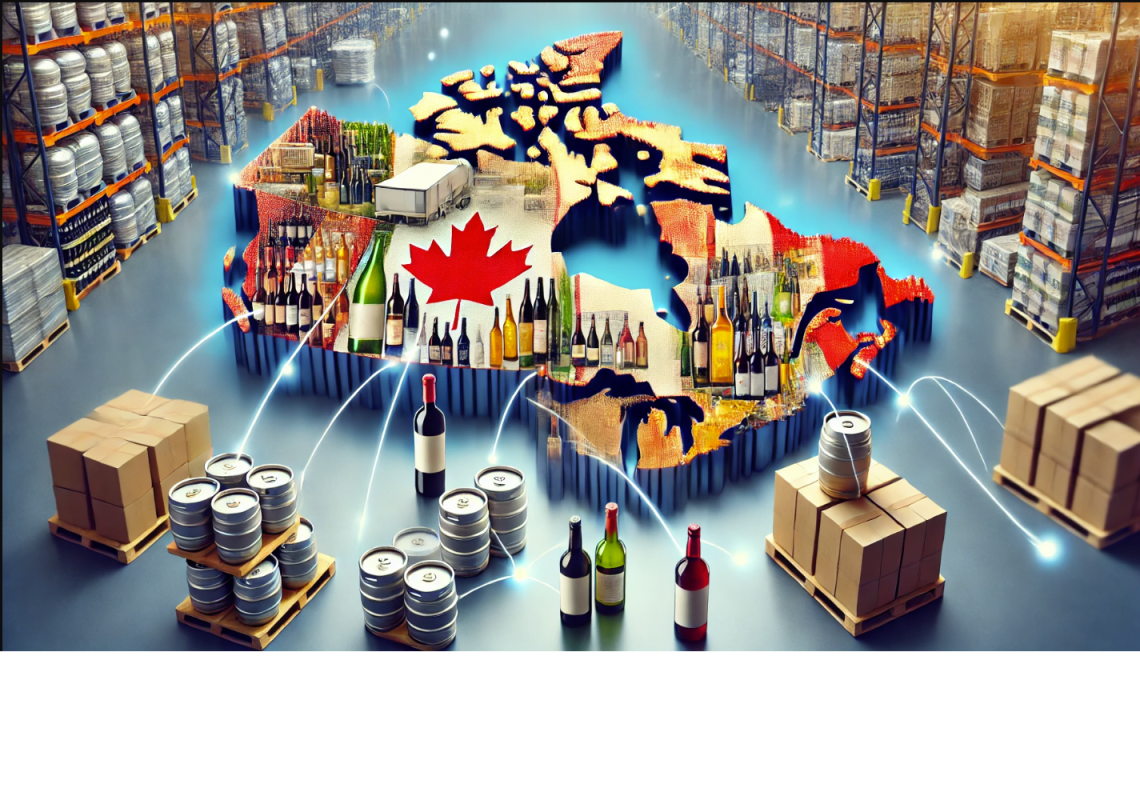Wine Law
Towards a More Efficient Pan-Canadian Alcohol Distribution System: Building on the Freeing of Interprovincial Trade Barriers
For decades, Canada’s alcohol distribution system has been defined by strict provincial controls, resulting in a fragmented and inefficient marketplace. Each province and territory operates its own liquor board, setting rules on importation, distribution, and retail sales. While these systems were initially designed to regulate alcohol consumption and generate revenue for provincial governments, they have also created significant trade barriers, limiting consumer choice, inflating prices, and restricting businesses from operating efficiently across provincial lines.
Recent moves to ease interprovincial trade barriers on alcohol are a welcome step toward a freer and more dynamic marketplace. Allowing wineries, breweries, and distilleries to sell directly to consumers in other provinces and enabling retailers to access products from across the country will foster greater competition and consumer access. However, while this progress is encouraging, it only scratches the surface of what is possible. If Canada is to build a truly modern and efficient alcohol distribution system, further reforms are necessary—reforms that go beyond interprovincial trade and address the structural inefficiencies at the core of the system.
This article proposes a bold yet practical solution: centralizing all alcohol distribution within Canada under a single importing and wholesaling system. By streamlining importation, Canada could eliminate unnecessary duplication, ensure all licensees have equal access to products at the same wholesale prices, and maintain provincial revenues through a fair and transparent taxation model.
The Current State of Alcohol Distribution in Canada
Alcohol distribution in Canada is a complex system shaped by historical, political, and economic factors. Each province and territory regulates its own market, leading to a patchwork of rules governing importation, distribution, pricing, and retail sales.
At the heart of Canada’s alcohol distribution system are the provincial liquor boards, which act as gatekeepers for both domestic and imported products. These entities oversee everything from wholesale pricing to retail operations, often operating as both regulator and retailer. Some provinces, like Ontario (LCBO) and British Columbia (BCLDB), have begun moving toward a wholesale system in which they continue to run their own government stores while acting as a wholesaler to private stores. Others, like Alberta, rely entirely on private retailers but still control wholesale distribution.
Each liquor board has its own procurement process, requiring importers and suppliers to negotiate separately with multiple agencies, leading to duplication, inefficiencies, and inconsistencies. The same product may be approved in one province but not another, and varying markup and tax structures create price discrepancies even for identical products. Additionally, liquor boards often source the same products under different terms and prices, increasing administrative costs and causing inconsistent product availability across provinces.
For example, a restaurant in Alberta might have access to a particular wine directly from the wholesaler, while a restaurant in Manitoba may not be able to access the product at all. Similarly, a private retailer in British Columbia may have to pay a different wholesale price for a case of whiskey than a retailer in Nova Scotia, simply due to differences in provincial liquor board markups and policies.
Moreover, the restaurant in Alberta gets a wholesale price, which is a significant discount to retail. However, a restaurant in Manitoba or Saskatchewan pays the same prices as retail for wines they need to mark up in their restaurant. The result is a lack of consistency and fairness across provinces, making it harder for businesses to compete on equal terms.
Additionally, large retailers like Costco face restrictions that prevent them from offering their Kirkland brand across all stores in Canada. In contrast, in countries with more unified distribution systems, major retailers can leverage their buying power to provide customers with consistent pricing and product selection nationwide. These restrictions limit competitive advantages for businesses operating in multiple provinces, reducing consumer access to exclusive products and special pricing opportunities.
Ultimately, the current provincial liquor board model is an outdated system that fails to reflect modern business needs and consumer expectations. The rigid structures serve more as barriers to trade and efficiency than as effective regulatory tools.
International Comparisons: What Canada Can Learn
Many other countries have more efficient alcohol distribution systems that provide valuable lessons for Canada. In the United States, while each state has its own regulations, there is greater flexibility in importation and wholesale distribution. Private distributors play a major role in ensuring that businesses have access to a broad range of products, and retailers can negotiate directly with suppliers for better pricing. However, the three-tiered system which requires separate importing, wholesaling and retailing ultimately creates inefficiencies of its own, for example, allowing too much concentration in the wholesaling and distribution end of the system where a few large distributors dominate and charge differential pricing.
The European Union takes an even more integrated approach, allowing free alcohol distribution across member states. While taxation structures vary by country, businesses are not burdened with provincial-style barriers that restrict access to suppliers and force duplicative negotiations. This model ensures that restaurants and retailers have access to thousands of products without excessive markup discrepancies between regions.
Another example can be found in our own backyard. Alberta offers a compelling example of a more open alcohol distribution system that continues to generate provincial revenues. Despite being only the fourth-largest province by population, Alberta has the highest number of available alcohol products in Canada. Under this model, the province imports all products, but only at the direction of private importing agents, who choose their products, quantities and set prices. Liquor stores, bars, hotels and restaurants order directly from the provincial wholesaler.
The province’s privatized retail model has led to increased competition, wider selection, and more dynamic pricing. With thousands of independent liquor stores sourcing products from a common wholesale network, Alberta consumers enjoy access to a far greater variety of products than those in provinces with government-run retail monopolies. This model demonstrates the benefits of a decentralized retail system with a competitive marketplace while still maintaining government revenue through taxation.
One clear takeaway from these examples is that a system with fewer barriers to alcohol distribution fosters a healthier market with more competition, better pricing, and greater product variety for consumers. Canada’s current model stands in stark contrast, limiting market efficiency and stifling competition.
How a Pan-Canadian System Might Work
Drawing from global best practices, Canada could design a system that is efficient, fair, revenue-generating, and offers the widest possible selection of alcoholic beverages. This system could be modeled on Alberta’s approach, with a single national importer—either a federal Canadian agency or a provincial agency responsible for nationwide importation. Another option would be two regional agencies, one for the East Coast and one for the West Coast, provided they operate under the same procurement framework. Multiple warehouses would be needed across the country to ensure timely fulfillment of orders to license holders.
Private importing agents would submit product requests through a centralized procurement platform. The national importer would then issue purchase orders with suppliers, coordinate consolidated shipping, and receive goods at designated warehouses. Upon arrival, the importer would duties, excise taxes, and freight costs. A flat tax per liter—adjustable by product type or alcohol content—would be applied, and importing agents would set wholesale prices that include their service fees.
Products would be stored in wholesale facilities, with importing agents covering monthly storage fees. When a license holder (restaurant, bar, hotel, or store) places an order, the product would be delivered, and the applicable taxes would be remitted to the relevant provincial government. Goods and Services Tax (GST) or Harmonized Sales Tax (HST) would be charged according to the license holder’s location, but this would function as a pass-through cost, as license holders can claim it as an input tax credit. Suppliers would be paid for any products that have moved out of the warehouse on a regular (weekly, bi-weekly or monthly) basis. Importing agents could choose to pay the supplier directly and receive payments from the importer/wholesaler.
There could also be an option for importing agents to set a retail price for consumers to buy directly from the importer/wholesaler. If a province maintained a government-run retail monopoly and, for reasons of efficiency, chooses to offer only a selection of products, their citizens could still select from the entire list, purchasing by the case and having product shipped directly to them. This would ensure that everyone has the opportunity to benefit from the system, regardless of their province of residence.
Federal labeling requirements would remain in place. Currently, product testing regulations vary widely across provinces. For example, Ontario mandates annual testing for every product, while Prince Edward Island accepts certificates from recognized laboratories. The proposed system would standardize testing by allowing certificates from internationally accredited laboratories, provided they meet specific safety criteria. Additionally, randomized testing and a risk-based assessment approach could be implemented to maintain consumer safety, with higher testing frequencies for product categories, countries, or suppliers that have shown previous compliance issues.
Canadian wineries, breweries, cideries and distillers could distribute directly to consumers and license holders across the country without having to remit the flat tax to the government, should they choose. Or they could have their products be listed on the national listing with distribution handled by the wholesaler. The flat tax rate assessed on these products would be lower than for imported products to reflect the lower cost of service. This could be a huge benefit to smaller, local producers, giving them easy access to the entire country with no barriers and low distribution costs.
Addressing Concerns and Implementation Challenges
One of the key concerns in transitioning to a national alcohol distribution system is ensuring that provincial revenues remain intact. This can be addressed by implementing a flat tax on wholesale transactions that ensures each province continues to collect revenue equivalent to what they generate under the current system. Additionally, careful policy design can prevent market dominance by a few large players, preserving opportunities for small and independent businesses.
Another potential challenge is logistical coordination across a country as large as Canada. However, modern logistics networks, temperature-controlled warehousing, and digital order management systems can ensure smooth operations, just as they do for large-scale retail and food distribution networks. Countries like Germany and Australia have demonstrated that a well-organized alcohol importation and distribution system can operate efficiently across vast geographic areas while maintaining high product availability and consumer satisfaction.
Conclusion: A Stronger, More Efficient Alcohol System for Canada
Canada has the opportunity to build a modern, efficient alcohol distribution system that supports innovation, competition, and accessibility. By adopting a unified wholesale system, it can create a fairer, more competitive industry that benefits businesses, consumers, and government alike. The benefit to the hospitality industry in particular would be huge, totally transforming the health of the industry and offering the potential for enormous increases in employment. With proven models available from international markets, Canada can craft a modernized system that addresses inefficiencies while maintaining necessary regulations.
Ultimately, the benefits of reform far outweigh the challenges. By fostering a competitive marketplace, reducing administrative burdens, and ensuring fair pricing across all provinces, a national wholesale system could be a transformative solution. Now is the time to embrace real change and modernize Canada’s outdated alcohol distribution system for the benefit of all stakeholders.

